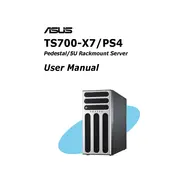ASUS TS700-X7-PS4 User Manual


To install an operating system on the ASUS TS700-X7-PS4 Server, begin by connecting a monitor and keyboard. Insert the OS installation media (DVD/USB) and power on the server. Enter the BIOS setup by pressing the 'Del' key during boot. Set the boot priority to your installation media. Save changes and exit the BIOS. Follow the on-screen instructions to install your desired operating system.
If the server does not power on, first check the power cables and ensure they are securely connected. Verify that the power outlet is functional. Check for any visible damage or loose connections inside the server. If the issue persists, consider testing with a different power supply unit.
To upgrade the RAM, power off the server and disconnect all cables. Open the chassis and locate the RAM slots on the motherboard. Remove the existing RAM by releasing the side clips. Insert the new RAM modules by aligning them with the slots and pressing down until the clips secure them in place. Reassemble the server and reconnect all cables.
The ASUS TS700-X7-PS4 Server supports several RAID configurations, including RAID 0, RAID 1, RAID 5, RAID 10, and RAID 50. These configurations can be set up using the onboard RAID controller through the BIOS or a dedicated RAID setup utility.
To reset the BIOS password, power off the server and disconnect it from power. Open the chassis and locate the CMOS battery on the motherboard. Remove the battery for about 10 minutes. Reinsert the battery, reassemble the server, and power it on. This will reset all BIOS settings, including the password.
The ASUS TS700-X7-PS4 Server supports up to eight 3.5-inch SATA/SAS hard drives, allowing for a maximum storage capacity of up to 32TB, assuming 4TB drives are used. This can be expanded further with additional storage solutions.
You can monitor the hardware health using the ASUS ASWM Enterprise software, which provides real-time monitoring of system components such as CPU temperature, fan speeds, and voltages. The software can be installed on a connected workstation for remote monitoring.
To update the BIOS, download the latest BIOS version from the ASUS website and save it to a USB drive. Reboot the server and enter the BIOS setup by pressing the 'Del' key during boot. Navigate to the EZ Flash utility and select the BIOS file from the USB drive to initiate the update process.
If the server's fans are unusually loud, check for dust buildup in the server and clean it if necessary. Ensure that the server is placed in a well-ventilated area. You can also check the fan settings in the BIOS to ensure they are set to automatic and not manually overridden to run at full speed.
While it is possible to use third-party components, ASUS recommends using ASUS-certified components to ensure compatibility and stability. If you decide to use third-party components, ensure they meet the specifications required by the server and test for compatibility before full-scale deployment.